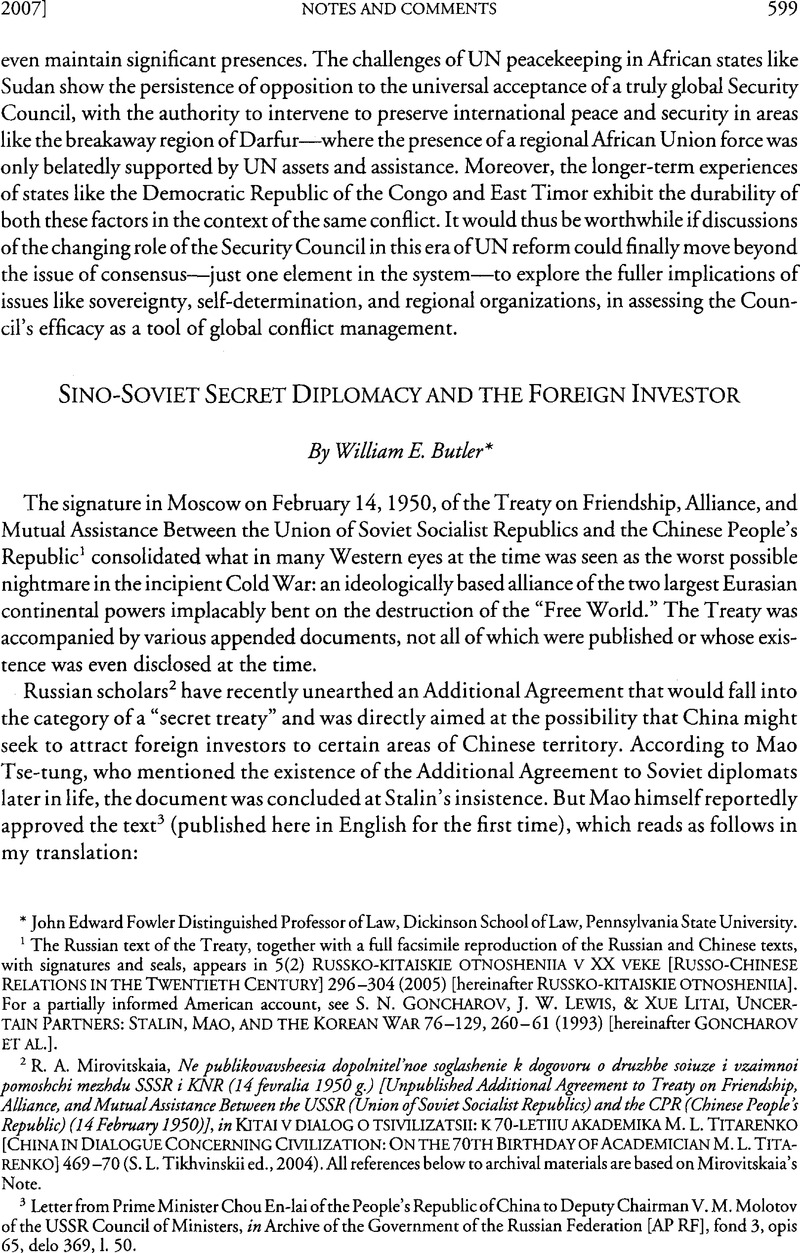No CrossRef data available.
Published online by Cambridge University Press: 27 February 2017

1 The Russian text of the Treaty, together with a full facsimile reproduction of the Russian and Chinese texts, with signatures and seals, appears in 5(2) Russko–Kitaiskie Otnosheniia V XX Veke [Russo–Chinese Relations In The Twentieth Century] 296–304 (2005) [hereinafter Russko–Kitaiskie Otnosheniia]. For a partially informed American account, see Goncharov, S. N., Lewis, J. W., & Xue, Litai, Uncertain Partners: Stalin, Mao, and The Korean War 76–129, 260–61 (1993)Google Scholar [hereinafter Goncharov Et Al.].
2 Mirovitskaia, R. A., Ne publikovavsheesia dopolnitel’noe soglashenie k dogovoru o druzhbe soiuze i vzaimnoi pomoshchi mezhdu SSSR i KNR (14 fevralia 1950 g.) [Unpublished Additional Agreement to Treaty on Friendship, Alliance, and Mutual Assistance Between the USSR (Union of Soviet Socialist Republics) and the CPR (Chinese People’s Republic) (14 February 1950)], in Google Scholar Kitai V Dialog O Tsivilizatsii: K 70–Letiiu Akademika M. L. Titarenko [China In Dialogue Concerning Civilization: On The 70th Birthday Of Academician M . L. Titarenko] 469–70 (S. L. Tikhvinskii ed., 2004). All references below to archival materials are based on Mirovitskaia’s Note.
3 Letter from Prime Minister Chou En–lai of the People’s Republic of China to Deputy Chairman V. M. Molotov of the USSR Council of Ministers, in Archive of the Government of the Russian Federation [AP RF], fond 3, opis 65, delo 369,1. 50.
4 AP RF, fond 3, opis 65, delo 369,1. 53 (typewritten text). The original kept in the Archive of Foreign Policy of the Russian Federation also bears the autograph signature of G. Mikheev, then head of the Treaty Section of the Treaty and Legal Administration of the USSR Ministry of Foreign Affairs.
5 Doc. 573 (Feb. 13, 1950), in 5(2) Russko–Kitaiskie Otnosheniia, supra note 1, at 295.
6 B. N. Vereshchagin, Vstarominovom Kitae [In Old and New China] 124 (1999). However, the existence of the Agreement had long been rumored, as had that of concomitant protocols whose texts are still not available. See Goncharov et al., supra note 1. For other Russian accounts, see notes 7 and 8 infra.
7 A. M. Ledovskii, SSSR I Stalin V Sud’bakh Kitaia [The Ussr And Stalin In The Fates of China] 138 (1999), reviewed by B. T. Kulik in 3 Novaia I Noveishalaistoriia [New and Recent History] 202 (2001). The existence of the Agreement, but not knowledge of the actual text, is recorded in Grosek, E., The Secret Treaties of History 337–38 (2d ed. 2007)Google Scholar. His account of the text, based on Goncharov Et Al., supra note 1, is not correct.
8 Kulik, B. T., Sovetsko–Kitaiskii Raskol: Prichiny I Posledstviia [Soviet–Chinese Schism: Reasons and Consequences] 15 (2000).Google Scholar
9 5(1–2) Russko–Kitaiskie Otnosheniia, supra note 1 (2005).
10 Archive of Foreign Policy of the Russian Federation [AVP RF], fond Za, opis 1, delo 105, 1. 9; see also 5(2) Russko–Kitaiskie Otnosheniia, supra note 1, at 302–03 (facsimile of Additional Agreement).
11 On this episode, see 4(2) Russko–Kitaiskie Otnosheniia, supra note 1, at 583 (1996)Google Scholar; Mirovitskaia, R. A., K istorii podpisaniia Dogovora o nenapadenii mezhdu Sovetskim Soiuzom i Kitaiskoi Respublikoi [On the History of the Signature of the Treaty on Nonaggression Between the Soviet Union and Chinese Republic], in Rossiia–Zapad—Kitai [Russia–West—China] 565–66 (2000)Google Scholar.
12 Chinese sources quoted in a Russian work declare that the Additional Agreement “was annulled in 1956,” presumably by the Chinese side. The same Chinese source alleges that the Additional Agreement “was directed solely at China; in other words, the Northeast and Sinkiang China became, without any doubt, two zones of influence of the USSR. Mao Tse–tung initially was against such an agreement but I. V. Stalin insisted. … ……” IU. M. Galenovich, Rossiia–Kitai: Shest’ Dogovorov [Russia–China: Six Treaties] 277 (2003).